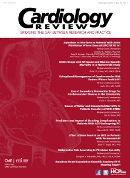Publication
Article
Cardiology Review® Online
Welcome to the New Year!

Debabrata Mukherjee, MD, MS, FACC
Editor-in-Chief
I
hope everyone had a wonderful holiday season and I want to wish everyone a very happy New Year. We start the first 2012 issue of the journal with several key clinical studies. Dr Noel G. Boyle discusses the effect of rate control on quality of life (QOL) in patients with permanent atrial fibrillation (AF) based on an analysis of the RACE II trial data, in which patients with permanent AF were randomized to lenient or strict rate control. Dr Boyle concludes that there was no difference in overall QOL measurements between the strict and lenient rate control groups; further, he notes, symptoms, age, sex, and underlying heart disease—but not the amount of rate control—influenced QOL. He points out that the choice of rate control versus rhythm control should be individualized, as well as the choice of lenient versus strict rate control.
As for antithrombotic choices in AF, Drs Jennifer G. Bekker, Sara D. Brouse, and Tracy E. Macaulay discuss the role of apixaban versus warfarin in the context of the Apixaban versus Warfarin in Patients with Atrial Fibrillation (ARISTOTLE) trial. They state that apixaban is the first agent to demonstrate the combined benefit of increased efficacy and safety versus warfarin and a significant decrease in mortality. When approved by the FDA, it will likely represent a preferred option for a patient population that has been committed to warfarin for many decades past.
Dr Eric R. Bates discusses causes of delay and associated mortality in patients transferred with STEMI. This is a critical component of care for patients with heart attacks and has a direct influence on survival. Dr Bates states that the ideal transfer strategy for patients with STEMI is direct transport to an angioplasty center, bypassing hospitals without angioplasty capability, with prehospital diagnosis and notification of the cardiac catheterization laboratory. However, only 50% of patients use emergency medical services and some of them are required to transport to the nearest hospital. Therefore, ideally all hospitals without angioplasty capability need to develop and participate in a regional STEMI transfer system to increase timely access to primary angioplasty.
Dr Marco Roffi comments on predictors and impact of bleeding complications in patients with acute coronary syndrome (ACS) undergoing percutaneous coronary intervention (PCI). Recent studies have highlighted the detrimental consequences of bleeding on survival, and Dr Roffi recommends being more selective in the administration of glycoprotein IIb/IIIa receptor inhibitors in patients treated with potent P2Y12 inhibitors such as prasugrel, and also increasing the use of a transradial approach that may reduce bleeding. We need to not only pay attention to ischemic events but also be cognizant of the risks associated with bleeding when using potent antithrombotics and antiplatelet agents.
Dr Gregory S. Pokrywka discusses an important societal issue—malpractice risk according to physician specialty. Overall, significant heterogeneity exists among specialtyspecific projections of career malpractice risk and cardiologists and internists are in the middle of the pack in terms of the proportion of physicians facing claims annually, both coming in slightly higher than the average for all physicians. Dr Pokrywka reminds us of the essential principles of being a good physician, which are to listen to our patients and respect them—2 of the best ways we can all prevent malpractice claims.
Several articles in this issue address optimizing secondary preventive therapies for cardiovascular diseases. Dr Peter H. Jones discusses statin usage and all-cause and diseasespecific mortality, confirming that long-term statin use provides one of the single most powerful ways to decrease cardiovascular deaths, with no trade-off on death from other causes. Along the same lines, Dr Leslie Cho discusses suboptimal management of cardiovascular risk factors, particularly in women, and recommends a disease-oriented team approach using other medical personnel such as nurses and pharmacists along with physicians to improve both adherence to guidelines and patient compliance with therapies. Dr Karla K. Quevedo discusses use of secondary prevention drugs for cardiovascular disease in the community and cogently points out that strategies need to be implemented according to the needs of the individual community; only with this targeted strategy will we be able to improve the population’s health and reduce the burden placed on health care resources related to CVD.
I hope that you will find these study synopses to be insightful and of value in your practice. I would like you to share your insights, thoughts, and experiences on topics touched upon in this issue. On a broader level, I would love to hear from you to provide feedback on how we can make this journal the best cardiology journal that reviews contemporary literature. My goal continues to be to make you look forward to every issue of Cardiology Review.

